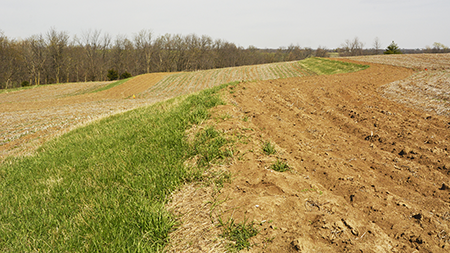The baby boomer generation is a large one. Folks in this group, born between 1946 and 1964, represent nearly 20 percent of the U.S. population. I’m in the tail end of that group, and like many people my age, I grew up on a farm, but no longer work on one. My children are now one more step removed from agriculture. Fortunately, they fondly remember their days riding in the combine and tractor cab with their uncles and grandpa.
Direct ties to agriculture are weakening, but the connection with the land remains strong. Everyone can get on the same page when it comes to protecting our soil and water for future generations.
As I look out of my office window, I can see the State Capitol in the distance. It is a nice view, but it doesn’t compare to getting out, beyond the office walls, to visit farmers on their farms. The smell of the grass and the earth beneath it stir good memories of growing up on our family farm.
Recently, I was able to savor those smells on farms near Salem and Savannah. They were visits to a farmer and his son who raise cows and calves in the Ozark foothills and a farmer whose primary job is to build structures in fields that reduce soil erosion. My visit was for an article in Missouri Farm Bureau’s member magazine, Show Me Missouri Farm Bureau. The focus was renewal of the one-tenth-of-one-cent sales tax for state parks, soils and water, particularly the soils portion.
Two of these farmers are baby boomers who continue to farm. The one with the cow herd says that because of the tax they have made improvements that not only help the health of pastures, but of their cattle. The benefits are many, but two stood out. Their efforts reduced soil erosion into a creek, which improved water quality, and allowed a son to continue to farm. The improvements to graze cattle made the farm much more efficient, enough so that the farm can support an income for both father and son on the same acreage. This is good news for the three grandsons who they hope continue in their footsteps one day. Improvements take money and only through a cost-share program funded by the one-tenth-of-one-cent sales tax are father and son able to make their farm better together.
Near Savannah, 30 years of building terraces, adding draining tiles and developing no-till farming methods has reduced soil erosion substantially. Less runoff means soil nutrients stay in the fields, not only benefiting the crops but protecting the water quality in the area. Farmers pay for up to 50 percent of the dirt work out of their own pocket, but Soil and Water Conservation Districts pay for a part as well, and that money comes from the parks, soils and water tax.
These farmers feel good about what they are doing. There is a sense of pride in caring for one’s slice of property, leaving the land in better shape than it once was and protecting the resources we all rely on.
For those less inclined to sentiment, numbers back up how these farmers feel. In 1982, Missouri was losing 10.75 tons of topsoil per acre annually, but by 2010 that rate dropped to 5.49 tons per acre, according to the National Resources Conservation Service. In 1984, voters first approved the parks, soils and water tax and have renewed it three times since. Coincidence? Not when you consider more than 177 million tons of soil have been saved from Missouri waterways because of the tax.
It seems like a pretty good return on investment to me. And, although I don’t farm, this baby boomer likes the idea of keeping Missouri soil in Missouri.


